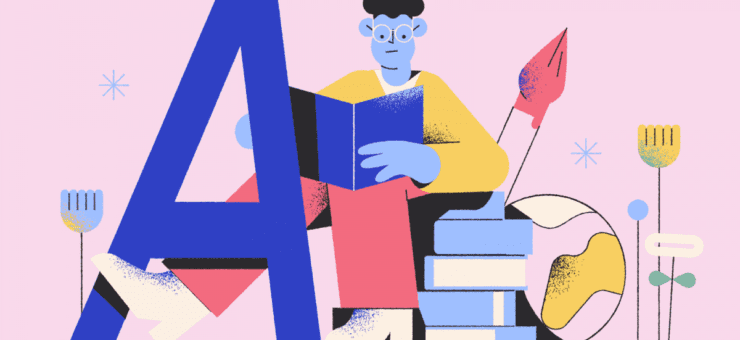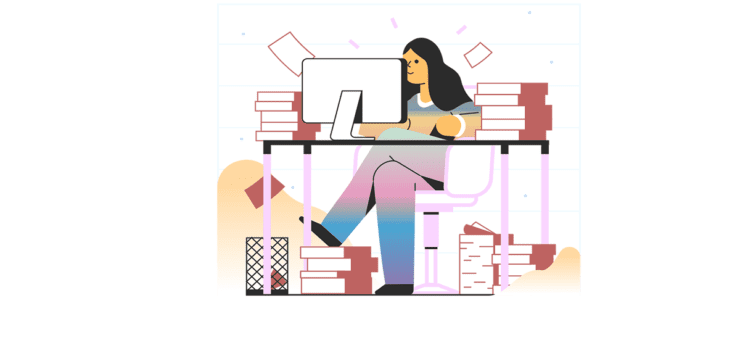Tiredness, lack of focus, and motivation are just a few of the most common symptoms of burnout.
Whether you’ve been working as a graphic designer for years or you’re new to the field, it’s normal to feel this way at any point in your career.
But what exactly causes burnout? The main culprits of job burnout for a designer include:
- Overly large workload leading to a poor work-life balance
- Working over the projects that you don’t really like
- Excessive focus on work
- Lack of inspiration
In this post, you’ll find some helpful tips on how to cope with all this and advice from other designers.
Control your workload
This step applies to freelancers and office-based designers: managing your workload is key to preventing and reversing burnout. When you first started your journey, you probably had the energy and stamina to eat design projects for breakfast, lunch, and dinner and snacking in-between meals. While it may feel great to have found something that you’re passionate about, you should develop a healthy balance between work and play from the get-go. Yes, design might feel like work and a hobby, but your brain can only handle so much of the same thing. So, what’s the solution?
Structure your day to ensure you have solid boundaries between work and rest. Create a comfortable schedule that you will stick to, with just the right amount of rest to make you feel fully replenished. We’re all different, so try different approaches to find the one that works for you.
If you work a 9-5 and your hours aren’t flexible, your schedule has been pre-determined. And that can help make life easier. If you know you’re working until 5, all that’s left for you to do is to switch off the “work mode” as soon as you leave your desk. It might be tempting to take on side projects after work, but make sure you do these only if they inspire you and feel like they’ll leave you with time to live your life.
You have more freedom to structure your day if you’re a freelancer or have no fixed schedule. But there are also more chances of your schedule becoming chaotic (or non-existent). Studies have shown that working in short and timed intervals can help keep things under control while helping you stay more focused and productive. Different people work best at different times of the day. Here are a couple of very opposite schedules that our interviewees shared with us.
Sarah, Boston
“I’ve never been into the whole 9-5, so it made sense that since I started freelancing, I haven’t had a single 8-hour workday. I try to start as early as possible – around 7 AM., and I try to wrap things up by about 1 PM-ish or earlier if I can. I also prefer to work in short sprints, but I do sometimes get carried away. My typical day looks like this:
7.30 AM: Look through my emails, messages, etc. This helps get all the stuff that I really don’t like doing out of the way first.
8-9 AM: I continue working on the projects I had from the previous day and/or projects with an urgent deadline.
9 AM: Coffee break.
9.30 AM: Finish up any work from yesterday.
10.30 AM: Go for a quick walk or watch something design-related.
11 AM: Work on new projects.
1 PM: Make a list of what I need to work on tomorrow.”
Marius, London
“I’m 110% a night owl, and I’ve found that working evenings/ nights is perfect for my productivity. There’s something about evenings that helps keep me focused. I get up at 11-12 PM, depending on how late I went to bed the night before. Then get all my life stuff done during the day and start working at around 6-7 PM. I used to work until early morning, but my health started suffering, so I try to take things easy nowadays. I’ve found it hard to stick to a schedule, but once I get into the flow, I think all my working hours generally follow the same structure:
6 PM: Write out what I’ll be working on today. Answer any messages and get back to clients.
6.30 PM: When I can, I like to start by working on my personal projects. This gets my creative juices flowing, and I feel ready to work on everything else.
7/7.30 PM: Work on projects that are due tomorrow/ soon and send them off.
9 PM: Work on projects with a longer deadline. Here I’ll usually just let myself get lost in my work, and I can finish anywhere from 11 PM to 1 AM. But again, I do try to control myself. I’ve found that if I stop working just before I get sleepy and tired, I’m much more excited to jump back in the next day!”
Whatever schedule you create for yourself, it’s essential to stick to the timing you decide on. If you start cheating yourself and working more than you planned, you risk falling into the burnout trap.
Choose your projects
This tip mainly applies to those who are free to choose projects, but even if you’re in full-time employment, you have a say in your work. If there’s a specific type of job that you don’t like — especially if it’s affecting your experience of the job as a whole — speak to your manager about it. Yes, there will always be things we don’t enjoy, but there should be much more you enjoy. Staying silent and suffering is a fast-track to burnout, so don’t shy away from this.
If you’re a freelancer, you always have a choice on whether you take on a project or not. Here are some questions that you can ask yourself to ensure the project is a good fit before you start:
Does the client know what they want? Do they sound like they have a clear (and realistic) goal in mind?
Clients with unrealistic goals may end up micro-managing every single part of the project, which usually drains the creativity out of the design process. This can eventually lead to feeling burned out.
Does the budget reflect what the client expects to achieve?
Low budgets and high expectations are often a red flag of a difficult client. If you work with difficult clients, you won’t feel motivated. The same goes for low paychecks.
Do I feel excited about the project?
Is this something that you’re passionate about? Will this project challenge you in the right way and help you grow as a designer? Does it reflect your interests outside of work? These questions will help you determine if you’re truly excited. No excitement = low creativity. And creativity is the fuel that graphic designers can’t live without.
Shift your focus
Most graphic designers begin their journey by working on projects as a hobby. But once you make the leap and graphic design transforms into something you do for a living, you’ll need to find ways to switch off from work. This means finding new hobbies.
Julie, Toronto
“I’ve always loved painting. Before I started working as a designer, I used drawing to calm my anxiety after work. It still helps with that, but most of all, I notice just how much more creative I am after a good paint sesh. I get so many new ideas that I then apply to my projects. So not only do I feel recharged, but it helps me work better and faster the next day.”
Julie’s observations aren’t that surprising. Studies have shown that spending more time on hobbies makes you perform between 15-30% better at work. Hobbies make you more creative and allow your mind to switch off from your routine tasks. When you feel refreshed and recharged, you’ll be far more excited and motivated about work. And you’ll be less likely to face burnout, as hobbies give you control over your time.
There’s no hard and fast rule on how to choose a hobby, but here are some points:
- Make sure it’s not what you do for your job. The more different it is to your work, the better for neuroplasticity and creativity.
- Hobbies don’t include watching TV or scrolling social media. These just tend to cause dissociation rather than giving you the ‘flow state’ that your brain needs.
- Spend at least 2 hours on your hobby every week. This is the bare minimum. But to feel satisfied, try to get in at least 40 minutes per day on average.
Feel inspired
Inspiration is key to the creative process. Not only that, but it’s also exactly what you need to feel motivated and ready to work again. If things always feel monotonous, you’re moving to the point where you feel burned out.
How does inspiration work? On a neurological level, it’s caused by alpha and gamma waves working together in the brain to produce a ‘spark’ or brief vision in your mind’s eye. On a physiological level, inspiration causes an increased production of serotonin and dopamine. These feel-good hormones help you hamper the production of the stress hormone cortisol. Clinical studies have shown that subjects who reported burnout had higher levels of cortisol.
For a long time, researchers believed that inspiration was something that happened to us – that we couldn’t control it. However, recent studies have shown that inspiration can be trained.
Kseniya, Kyiv
“Sometimes I get up from my desk and just look around. I like to find inspiration in everything. For example, I was in our office kitchen the other day, and I noticed how great the writing on a wall behind our sink looked. I loved how it matched with the objects in front of it (the tap and tableware). They didn’t take away from the text at all. Instead, it looked like the text belonged there and had become a natural part of the environment. I usually experiment with something like this in my work. This is a random example, but it’s kind of how I train my mind to feel inspired. I also enjoy looking at how other creatives use fonts and love to feel inspired by unusual color combinations and textures.”
You can feel inspired by pretty much anything. Don’t limit yourself to scrolling through Dribbble and Behance. Your surroundings have lots to offer, too!
However, if you’re at the point where none of these steps feel inspiring or give you hope, it’s worth taking some time out to get a break from graphic design. 99% of the time, you’ll get to a point where you miss it and can come back and work in a much more balanced way (keeping in mind all of the above steps). Sometimes, all you need is a fresh start at a new workplace with conditions that match your needs. Browse different graphic design job listings to see what other companies have to offer.
Title image from Moose Photo Stock.
See also:


